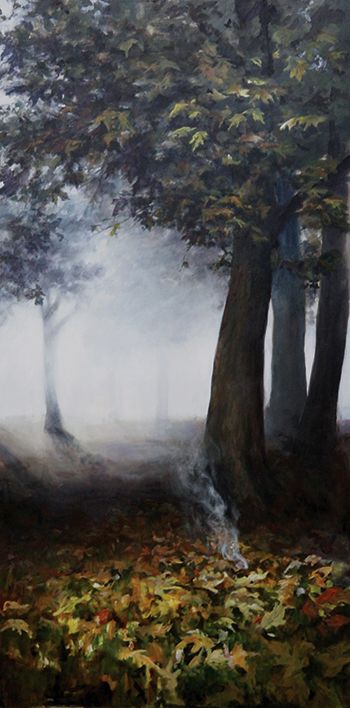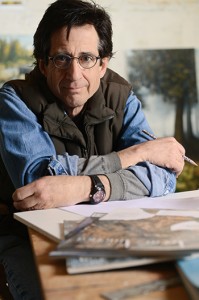Written by Sophia Ahmad

When Michael Brangoccio was in third grade, he was kicked out of class for drawing on his clothes. In college, he finished his first final in 20 minutes and spent the remainder of the class time doodling on his test sheet.
“I got an F, but the teacher wrote back and said, ‘I like your drawings,’ ” recalls the West Des Moines artist.
His artistic drive was matched by a compulsion to understand art from a technical perspective, propelling him to systematically study how things work. When he was 8, he tried to make his own fireworks, a project that blew up in his face, spewing shards of metal that sliced through his finger and pierced through a porch roof. At age 12, he bolted an electric furnace motor to the hardwood floor of his bedroom, took it apart and rebuilt it.
“I always tell people that creativity and art go together, but they’re not one and the same,” Brangoccio says. “You have to be constantly learning and constantly challenging yourself.”
 With a combination of talent, technical proficiency and work ethic, Brangoccio, now 59, has cultivated a multi-decade career that has included more than 50 solo exhibitions and 40 group shows across the nation. His works are part of private and public collections around the world. Current projects include a commission featuring a painting and a 22-foot-long multimedia wall for a corporate plant in Shanghai; a painting for a private client in Colorado; and work as a set design consultant for an upcoming musical production in Oskaloosa.
With a combination of talent, technical proficiency and work ethic, Brangoccio, now 59, has cultivated a multi-decade career that has included more than 50 solo exhibitions and 40 group shows across the nation. His works are part of private and public collections around the world. Current projects include a commission featuring a painting and a 22-foot-long multimedia wall for a corporate plant in Shanghai; a painting for a private client in Colorado; and work as a set design consultant for an upcoming musical production in Oskaloosa.
Brangoccio’s paintings present objects in new and unusual contexts, creating thought-provoking and, at times, humorous imagery. Trains follow railroad tracks up into the air, and fish are trapped in an aquarium adjacent to the ocean. He employs animals, frequently bears, as metaphors to represent human struggles and emotions in works that blur the line between representational and surreal.
“I like the interaction of what we think of as normal and abnormal and the junction of representational images in unusual circumstances,” he says. The paintings “beg the questions of ‘what is happening?’ and ‘why?’ I’m not preaching as much as I’m asking people to consider the situation and use their own experiences.”

“He’s technically a very good painter, and his work lands somewhere between whimsy and surreal,” says Susan Watts, owner of Olson-Larsen Galleries in West Des Moines, which represents Brangoccio. “He seems to accomplish an otherworldly feel. There’s no one else doing anything like that—I have truly never seen artwork like his before.”
Brangoccio grew up in rural Colorado just north of Denver. His parents didn’t understand his passion for art; his late father, a salesman who lived through the Great Depression, hoped his son would pursue athletics and make a solid living in a more traditional field. At one point, the young artist overheard his parents discuss therapy for him since he was so different from the other kids.
It wasn’t until Brangoccio was in his mid-20s that his parents’ expectations of him changed. By that time, he had become the first person on either side of his family to go to college, having earned a Bachelor of Fine Arts with an emphasis in painting and drawing from the University of Northern Colorado. He followed up with a Master of Fine Arts in two- and three-dimensional design and composition from the same school. Shortly thereafter, in 1984, he landed his first solo exhibition at a gallery in Denver. There, his paintings sold for around $8,000 each, and his parents were among those in attendance.
Brangoccio’s father “looked and saw how much they sold for and his mouth dropped,” Brangoccio recalls. “He couldn’t believe it.
“It felt weird—it felt good,” he says about finally earning the validation he had been seeking since he was a child. “After that, every time I had a show, he was there.”
In graduate school, Brangoccio’s knack for strategic experimentation led to a discovery that would become his signature style for years to come. Like many artists, he repainted on the same canvas over and over, forming a thick layer of acrylic. In the first year of his degree program, he removed his canvas from the stretcher and beat it against the side of the art building. A crowd of students gathered to watch. The paint chipped off slowly and irregularly, creating a crackled, textured finish.
“It was so fascinating how sensitive the surface was,” he says. “To have such an aggressive act create such a sensitive surface was really something.”
For Brangoccio, this experience became a metaphor of how life events—both painful and joyful—help shape each person’s character. “We become sensitive to all of these minute layers of texture” in our experiences, he explains.
 Growing Reputation
Growing Reputation
As Brangoccio’s reputation grew, his work continued to gain attention. He spent 1985 to 1990 in Los Angeles, where his work was represented by the Ruth Bachofner Gallery. His style skewed more abstract during that period.
“It was abstract, but you could still see some figures in it,” gallery founder Ruth Bachofner says. “There are a lot of layers that came through—it’s like his paintings are telling a story.”
His time in California was followed by a yearlong stay in Chicago. During this time, even as his career accelerated, he consistently challenged himself. “When you know what good (art) is and you can articulate it, then you have something to shoot at,” he says.
Brangoccio and his wife, Kim, came to Iowa in 1991 when she landed work as a marriage and family therapist. They moved to Muscatine and then to West Des Moines before starting a family; the couple has two children, 18-year-old Sarah and 16-year-old David.
Brangoccio soon began a multiyear relationship with Musco Lighting, an Oskaloosa business that has illuminated three Olympic Games, four Super Bowls, the Statue of Liberty and Yankee Stadium. He regularly creates artwork for the company, including a multimedia display at the Iowa Hall of Pride and large-scale photographic murals. He also serves as a consultant there.
“Mike has a unique balance of finding creative solutions to create value,” says Jeanie Bieri, director of marketing at Musco Lighting. “He does have such an interesting way of looking at things, but the whole goal (of his work) is to actually solve a problem.”
 Works of Faith
Works of Faith
In recent years, Brangoccio’s faith has steered his career and influenced his work. “I decided that since there is a God smarter than I am, I should do the things he does, like caring for other people,” he says.
He served as an artist in residence at Lutheran Church of Hope in West Des Moines from 2005 to 2009, where he taught classes in creativity, painting and drawing. He also created two large-scale paintings and designed a sprawling, 226-foot concrete outdoor wall on which church members painted personal statements of gratitude.
Currently, Brangooccio is pitching a multifaceted project to health care providers and hospitals. It includes paintings and an interactive kinetic sculpture, decked out with wheels, pulleys and other mobile objects. It also has an online game component in which a young patient is an avatar hero, and doctors and nurses can choose virtual characters to help defeat the common enemy: the disease.
“It occurred to me that if I can create or do something artistic that helps them …. (then) I have purpose,” Brangoccio says.
Overall, Brangoccio hopes his work expresses human experience and offers some inspiration, he says. One of his favorite paintings, “Punching Bag” (opposite page), depicts this goal. Portraying a seated bear staring down a punching bag, the work is about facing challenges.
“You have a choice,” Brangoccio says. “What are you going to do? If there’s something that you really, really want to do, just go out and do it.”








